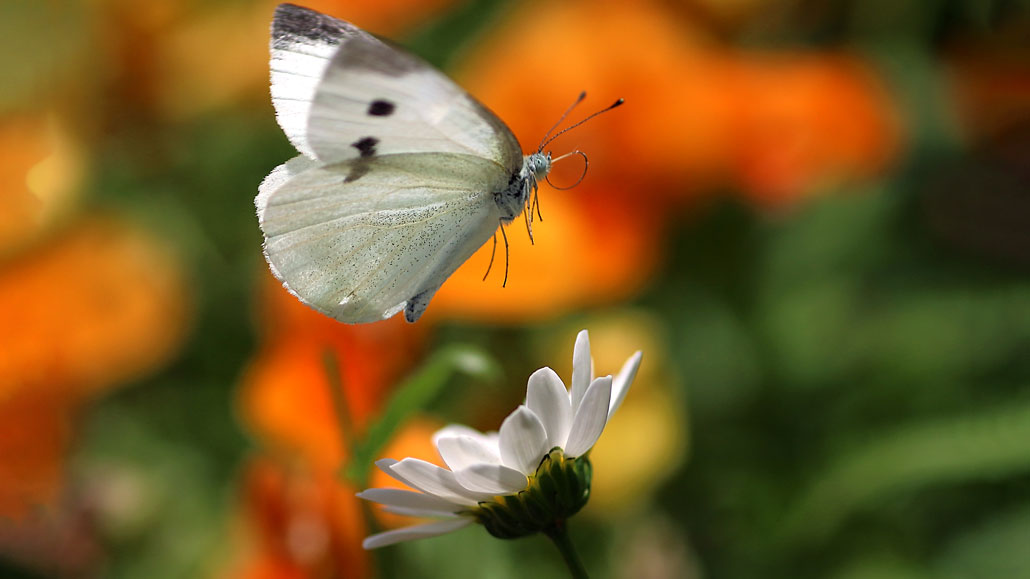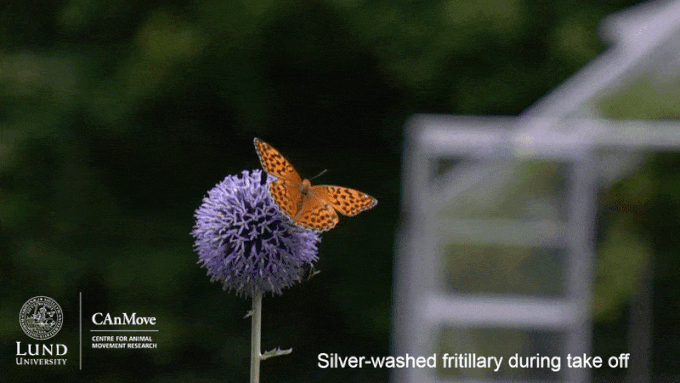Butterflies use jet propulsion for quick getaways
Clapping their wings creates air pockets that generate forward thrust

This cabbage butterfly’s wings lifted it during takeoff. As they snap together in a wing clap, they will propel it forward.
shene /Moment/Getty Images Plus
Butterflies aren’t the strongest fliers. Their large wings cause them to flutter about, rather than generating more direct flight paths. But that fluttery flight makes it hard for predators to catch them. And if you have ever tried to catch a resting butterfly, you know they are surprisingly difficult to nab. A new study helps explain why. Butterflies clap their wings above their bodies during takeoff. The move creates jet propulsion for a quick getaway.
Christoffer Johansson and Per Henningsson are evolutionary ecologists at Lund University in Sweden who study how flight has evolved in animals. Previous research had suggested that a butterfly’s overhead wing clap forces the insect forward. Researchers thought the wing clap likely formed a pocket of air that shoots out like a jet. But no one had tested that.
Until now.
Johansson and Henningsson caught six butterflies in a meadow near their lab. Each of these silver-washed fritillaries was housed in a net enclosure and fed honey water. To analyze their flight, the scientists placed the butterflies one at a time inside a wind tunnel.
Wind tunnels use fans to move air at specific speeds. When an object is placed in the tunnel, the air has to flow around it. This lets researchers test how objects move though air. “Smoke” made of tiny harmless droplets of oil is often added so researchers can observe precisely how air flows around something. This shows how aerodynamic the object is. (Aerodynamics refers to how air moves around solid objects.)
For this study, fans moved the air just enough to keep the smoke evenly distributed in the tunnel. The researchers also used a laser to light up a layer of smoke in the tunnel just behind the butterfly. Four high-speed cameras placed around the feeding station captured the movement of the butterfly and the smoke as the butterfly was taking off. This let the researchers create a 3D picture of that air movement as the insect flapped its wings. For each trial, the researchers placed a butterfly at a feeding station in the middle of the tunnel. They began recording when the butterfly took flight on its own.
They analyzed a total of 25 takeoffs by the six butterflies. Each included up to three wingbeats after takeoff. The butterflies proved more likely to clap their wings together during the first few wingbeats than later in flight.

A vortex occurs when air or water spins around a central point, like a whirlpool. And the images of the butterfly paths showed air swirling in a vortex as their wings moved. The photos also revealed that the wings’ downstroke pushed air down. This created a force that pushed the butterfly up. When the wings moved up to clap, they made an air pocket. This pocket created a strong jet of air that shot out between the wings behind the butterfly. That jet propelled the insect forward.
Both forces created by the wings give rise to a fluttery flight path. The butterflies rise as their wings move down and shoot forward as their wings move up. A wing clap on takeoff, paired with a quick turn, allowed the butterflies to flit away quickly. “It is crucial for the butterflies that they can take off fast in order to minimize the risk of getting caught” by predators, Henningsson notes.
Flexibility is key
He and Johansson noticed the wings formed the puffed-out pocket just before clapping. They wondered if the wings’ flexibility and this pocket improved the jet propulsion created by the clap. To find out, they made two simple models of butterfly wings. One set was made from balsa wood and was rigid. The other was made from a sheet of latex, a flexible plastic. They attached each set to hinges and rods that moved to mimic butterfly flight.
The pair then studied the air flow created by the two models as they were clapped in the same manner. The rigid wings did not form an air pocket. They instead created two vortex rings. This would make flight “less efficient,” Henningsson explains, “since more energy is wasted forming two rings.” The flexible wing models, however, created a stronger jet of air and just one vortex ring. It behaved more like true butterfly wings.
The team published its findings January 20 in Journal of the Royal Society Interface.
“These large and flexible wings are rather good at clapping,” Henningsson says. The pocket shape “dramatically improves the clap by trapping more air and creating a stronger jet.” Researchers thought they knew how the clap worked, he notes. But it’s “far more advanced and sophisticated” than anyone realized.
“The study is exciting,” says Ayodeji Bode-Oke. He is a researcher at the University of Virginia in Charlottesville. He has studied the mechanics of how insects move, though he was not part of the new work. This is the first study to measure the jet created by butterfly wings, he notes. That means “we have a better understanding of how butterflies fly,” Bode-Oke says. As an aerospace and mechanical engineer, he is particularly interested in how the study might inform designs for small flying vehicles, such as flapping drones.







